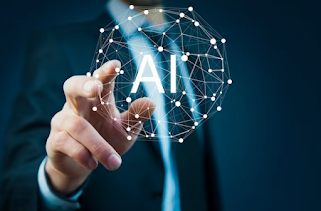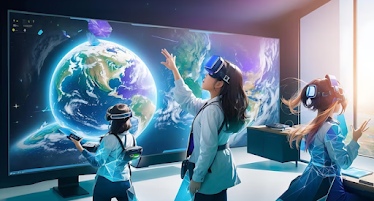The extraordinary job of man-made reasoning and AI in the improvement of virtual games
In the steadily developing scene of the gaming business, virtual game improvement has arisen as a power to entrance gamers with a vivid encounter that obscures the lines among the real world and fiction. The union of man-made consciousness (artificial intelligence) and AI (ML) has turned into a distinct advantage in virtual game turn of events, reclassifying the limits of imagination, submersion and gaming experience. By utilizing these state of the art innovations, a virtual game improvement organization can rethink player encounters, from practical conditions and insightful NPCs to versatile game mechanics. In this article, we dig into the thrilling domain where advancement meets creative mind and uncover the significant effect simulated intelligence and ML are having on the development of virtual gaming.
What is a virtual game turn of events?
Virtual game improvement includes the complicated course of planning, making and working on vivid computerized encounters in a recreated climate. The virtual game improvement organization has some expertise in the formation of these virtual universes, where state of the art advancements, creative representation and specialized ability consolidate energizing stories, complex game mechanics and outwardly dazzling scenes. Through a cautious mix of workmanship and programming, these organizations utilize advanced devices, for example, man-made brainpower and AI to make intuitive universes that draw in and connect with players, giving a consistent mix of creative mind and innovation in the gaming scene.
The job of computerized reasoning and ML in the improvement of virtual games
The virtual game improvement organization offers an assortment of state of the art virtual game improvement benefits that utilize trend setting innovations like man-made brainpower (simulated intelligence) and AI. They assume a significant part in different parts of virtual game turn of events, improving ongoing interaction, illustrations, client experience and generally match-up plan. A virtual game improvement organization covers an extensive variety of mastery, including:
PCG (Procedural Substance Age):
A virtual game improvement organization utilizes simulated intelligence and ML strategies to procedurally create game substance like landscape, levels, surfaces and assets. It gives a dynamic and flexible gaming experience, keeping players connected with and drenched in consistently developing virtual universes. Brain organizations: The virtual game improvement organization involves profound learning brain networks for errands, for example, character movement, looks and lip adjusting, bringing about additional practical and dedicated game characters that respond truly to the player's activities.
Ongoing Beam Following:
Spearheading the fate of game visuals, the virtual game improvement organization utilizes procedures in view of man-made reasoning, for example, profound learning-based sound decrease to speed up continuous beam following, which adds to the components of lighting, shadows and reflections . . . eventually expanding visual authenticity and raising in general graphical devotion to extraordinary levels.
Normal Language Handling (NLP):
The virtual game improvement organization utilizes NLP calculations to make dynamic and context oriented discourse, advancing communications with non-player characters (NPC) and upgrading narrating, bringing about a profoundly vivid story experience for players.
Conduct Trees:
At the front of development, the virtual game development company utilizes the force of simulated intelligence based conduct trees to direct NPC activities and navigation, bringing about especially similar and dynamic in-game substances that consistently adjust to a changing player - elements.
Support Learning (RL):
Virtual game advancement administrations use support learning (RL) to prepare NPCs, empowering flexibility and making impressive rivals that continually challenge players and advance vivid ongoing interaction.
Procedural Liveliness:
In virtual game improvement administrations, ML calculations share certifiable movement information to make sensible liveliness for characters, animals, and items, adding smoothness and legitimacy to in-game exercises, upgrading the in general vivid experience.
Dynamic Trouble Change (DDA):
Best in class virtual game improvement administrations use simulated intelligence controlled DDA calculations to survey player expertise and progressively tweak game trouble, giving a vivid encounter that adjusts difficulties to every player's extraordinary capacities.
Prescient Examination:
Influence current innovation in virtual game advancement administrations utilizing ML models to break down player conduct and inclinations, making customized encounters, designated advertising and content proposals that extend game local area commitment.
Style Move:
In virtual game advancement administrations, ML methods, for example, brain style move offer the capacity to relate workmanship styles with in-game pictures with the assistance of computer based AI development. This gives the game world an exceptional and outwardly fascinating look that separates it from customary plan and improves the general tasteful allure.
Hostile to conning frameworks:
Simulated intelligence based enemy of tricking frameworks use design acknowledgment and irregularity discovery to recognize and forestall duping conduct, keep up with fair play and guarantee a level battleground for all players.
Pathfinding and Route:
ML-based pathfinding calculations assist NPCs with exploring complex conditions and stay away from obstructions by working on their spatial mindfulness and making more brilliant and more competent virtual units.
Computerize game testing:
ML-based testing systems can reenact player conduct and recognize game bugs, blunders and irregular characteristics, working on the QA interaction and guaranteeing a cleaned final result.
Genuinely Based Delivering (PBR):
Artificial intelligence controlled PBR strategies improve material properties, bringing about additional reasonable surfaces and light collaborations that upgrade visual submersion.
Character Customization:
ML models examine the player's inclinations and make custom characters, attire and embellishments, permitting players to make extraordinary symbols that match their singular styles and inclinations. The reconciliation of man-made intelligence and ML is reforming the way in which games are made, experienced and created. From making practical NPCs to making huge game universes, from further developing illustrations to anticipating player conduct, man-made intelligence and ML are driving advancement and increasing current standards for intelligent diversion.
Shamla Tech's ability in changing virtual game improvement through the reconciliation of artificial intelligence and ML
Shamla Tech, a main virtual development company, flawlessly coordinates man-made intelligence and ML innovations into virtual game advancement administrations. We use cutting edge simulated intelligence calculations and AI models, work on game mechanics, make dynamic NPCs, upgrade procedural substance creation and give sensible virtual conditions. Utilizing man-made intelligence and ML capacities, we advance client encounters, work on versatile narrating and improve asset portion for remarkable interactivity. Our aptitude guarantees that artificial intelligence and ML are consistently associated with the advancement of virtual games, pushing the limits of development and the gaming business.



Comments
Post a Comment